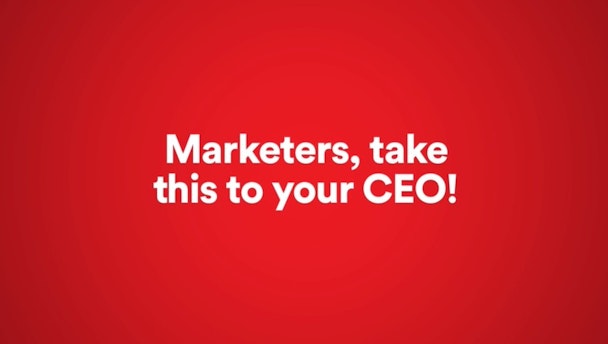Marketers, take this to your CEO
The ‘cookiepocalypse’ is coming, whether we like it or not. In January 2020, Google sent shockwaves across the advertising industry when it issued the death warrant for third-party cookies, setting in motion plans to eliminate them on the Chrome browser by 2022. The adtech community was up in arms, with advertisers, agencies, publishers and their digital ad partners scrambling to find alternative solutions. According to Criteo’s recent research in Q3 2021, a survey of over 100 UK marketers with spending authority over digital marketing found that 45% felt puzzled, stressed and angry when they found out the news.

Marketers take this to your CEO
Fast forward 18 months and Google threw the industry a lifeline, delaying the inevitable and pushing the deadline for the death of third-party cookies to late 2023. But that’s no reason to get complacent. It’s not just a marketing problem, it’s a business problem – and the future of commerce is in jeopardy unless marketers act now to find new solutions.
In this exclusive fireside chat with The Drum, Shruthi Chindalur, executive managing director EMEA at Criteo, outlines the business incentive for marketers to begin transformation now, exploring technology’s role in future proofing commerce for a world beyond the walled gardens.
Watch the interview above.
“Change is coming and it’s not just marketers’ burden to carry,” says Chindalur. “It’s easy to become casual about the upcoming cookiepocalypse – even the name sounds like a joke – but it’s a real issue and one with implications that reach far beyond marketing.”
Chindalur regales how Criteo’s chief executive officer Megan Clarken likened the current trouble around third-party cookies to the Y2K Bug – although she noted that while the Y2K panic had very little impact, the cookiepocalypse represents a fundamental disruption of the entire online ecosystem.
“Perhaps the cookiepocalypse isn’t going to leave us at risk of nuclear meltdown or planes falling out of the sky, but for marketers it is the end of the world as we know it,” says Chindalur. “And for businesses too, actually.”
She goes on to explain how third-party cookies were all about helping marketers see their audience, and that by removing them we’re “essentially turning out the lights”, which changes the entire commerce journey.
“If a business doesn’t know who it’s dealing with, it can’t share personalized content, it can’t optimize the experience, it can’t take any lessons from the consumer journey and any measurement will be fragmented and inaccurate.”
Chindalur also cites research that shows 66% of online activity and sales happen outside the walled gardens, on the open web, and yet only 37% of ad spend goes here. She argues that not only are marketers over indexing on walled gardens but sometimes even spending their money blindly.
“Clearly some kind of balance is needed – an approach that gives us access to all audiences. This is where our First-Party Media Network comes in. It works for marketers and media owners to help share first-party data – with the customer’s permission – and to add to their own knowledge with Criteo’s commerce data and build campaigns that are based on outcomes rather than simply taking a punt on discreet audiences. And so, campaigns can run seamlessly across the open internet and walled gardens, finding the right audience without compromise.”
Contextual advertising helps provide access – and is now very much back in the spotlight as a way for advertisers and publishers to drive significant business outcomes without third-party cookies.
“As marketers, we have been grappling continually with how we reach audiences in a data-privacy-minded way and this is why solutions such as contextual advertising are back in vogue – but with new and improved technology like machine learning and artificial intelligence to do it right,” says Chindalur.
It’s important to note that other browsers Safari and Firefox have already sunset third-party cookies – and still, they account for a third of online activity. This means that marketers have a real opportunity to explore new solutions happening in environments without third-party cookies.
“Our contextual campaigns have less than 1% audience overlap with other traffic acquisition campaigns that our clients are running. And up to 90% of this traffic that we’re driving to clients’ sites through contextual campaigns, have never visited their sites before. We’re doing all of this while maintaining key KPIs in line with the other mid-funnel campaigns the client is running.”
Over the last year, Criteo has transformed from a single-product company in retargeting to offer a variety of technology solutions that can address the full range of marketing objectives. It has pushed to become a leader in Commerce Media – a new approach to digital advertising that combines commerce data and intelligence to target consumers throughout their shopping journey and help marketers and media owners drive commerce outcomes. This, Chindalur believes, “is the future state of adtech”.
“If you have a sizeable commerce dataset comparable only to the walled gardens, if you have superior AI capabilities, if you have enormous reach across a network of media assets and if you have years of expertise in performance and driving outcomes, only then can you launch targeting to these new heights.”
Content created with:

Criteo
Criteo is a global technology company that powers the world’s marketers and media owners with trusted and impactful advertising through our world-leading Commerce...
Find out more
